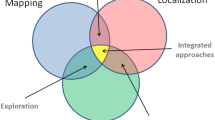Abstract
Real-time obstacle avoidance is essential for the safe operation of mobile robots in a dynamically changing environment. This paper investigates how an industrial mobile robot can respond to unexpected static obstacles while following a path planned by a global path planner. The obstacle avoidance problem is formulated using decision theory to determine an optimal response based on inaccurate sensor data. The optimal decision rule minimises the Bayes risk by trading between a sidestep maneuver and backtracking to follow an alternative path. Real-time implementation is emphasised here as part of a framework for real world applications. It has been successfully implemented both in simulation and in reality using a mobile robot.
Similar content being viewed by others
Explore related subjects
Discover the latest articles, news and stories from top researchers in related subjects.References
Adams, M., Hu, H., and Probert, P.J. 1990. Towards a real-time architecture for obstacle avoidance and path planning in mobile robots. InProc. IEEE Int. Conf. Robotics and Automation, pp. 584–589, Cincinatti, USA.
Arkin, R.C., 1989. Motor schema-based mobile robot navigation.Int. J. Robotics Research, 8(4):92–112.
Berger, J.O. 1985.Statistical Decision Theory and Bayesian Analysis. Springer Verlag New York Inc., USA.
Borenstein, J. and Koren, Y. 1989. Real-time obstacle avoidance for fast mobile robots.IEEE Trans. Systems Man and Cybernetics, 19(5):1179–1186.
Borenstein, J. and Koren, Y. 1990. Real-time obstacle avoidance for fast mobile robots in cluttered environment. InProc. IEEE Int. Conf. Robotics and Automation, pp. 572–577.
Borenstein, J. and Koren, Y. 1992. Noise rejection for ultrasonaic sensors in mobile robot applications. InProc. IEEE Int. Conf. Robotics and Automation, pp. 1727–1732, Nice, France, May.
Brady, J.M., Cameron, S., Durrant-Whyte, H., Fleck, M., Forsyth, D., Noble, A., and Page, I., 1987. Progress towards a system that can acquire pallets and clean warehouses. InFourth Int. Symp. Robotics Research, Santa Cruz, August.
Brady, J.M., Durrant-White, H., Hu, H., Leonard, J.J., Probert, P.J., and Rao, B.S.Y. 1990. Sensor-based control of AGVs.IEE Journal of Computing and Control Engineering, pp. 64–70, March.
Brooks, R.A. 1986. A robust layered control system for a mobile robot.IEEE J. Robotics and Automation, 2:14.
Cameron, A. 1989.A Bayesian Approach to Optimal Sensor Placement. PhD thesis, University of Oxford, U.K.
Chatila, R. and Laumond, J.P. 1985. Position referencing and consistent world modeling for mobile robots. InProc. IEEE Int. Conf. Robotics and Automation, p. 138.
Polaroid Corporation 1984.Ultrasonic Ranging System. Cambridge, Mass.
Dickson, W. 1991.Image Structure and Model-based Vision. PhD thesis, University of Oxford.
Durrant-Whyte, H.F. 1987.Integration, Coordination, and Control of Multi-Sensor Robot Systems. Kluwer Academic Press, Boston, MA.
Elfes, A. 1987. Sonar-based real-world mapping and navigation. InProc. IEEE Int. Conf. Robotics and Automation, pp. 249–265.
Elfes, A. 1990. Ocucupancy grids: A stochastic spatial representation for active robot perception. InProc. of the 6th Conference on Uncertainty in AI, July.
Ferguson, T.S. 1967.Mathematical Statistics—A Decision Theoretic Approach. Academic Press, Inc.
Hager, G. 1988.Active Reduction of Uncertainty in Multisensor Systems. Ph.D thesis, University of Pennsylvania.
Hollier, R.H. 1987.Automated Guided Vehicles. IFS, London.
Hu, H. 1992.Dynamic Planning and Real-time Control for a Mobile Robot. Ph.D thesis, University of Oxford.
Hu, H., Brady, J.M., and Probert, P.J. 1993. Transputer architecture for sensor-guided control of mobile robots. InProc. of World Transputer Congress'93, Aachen, Germany, Sept.
Hu, H. and Brady, M. 1992. Planning with uncertainty for a mobile robot. InProc. of 2nd Int. Conf. on Automation, Robotics and Computer Vision, Hyatt Regency, Singapore, 15–18 September.
Khatib, O. 1986. Real-time obstacle avoidance for manipulators and mobile robots. InInt. J. Robotics Research, volume RR5:1, pp. 90–98.
Koren, Y. and Borenstein, J. 1991. Potential field methods and their inherent limitations for mobile robot navigation. InProc. IEEE Int. Conf. Robotics and Automation, pp. 1398–1404, Sacramento, California
Kuc, R. and Viard, V.B. 1991. A physically based navigation strategy for sonar-guided vehicles.Int. J. Robotics Research, 10(2):75–87, April.
Leonard, J.J. and Durrant-Whyte, H.F. 1992.Directed Sonar Sensing for Mobile Robot Navigation. Kluwer Academic Publishers.
Moravec, H.P. and Elfes, A. 1985. High resolution maps from wide angle sonar. InProc. IEEE Int. Conf. Robotics and Automation, pp. 116–121.
Premi, S. and Besant, C. 1983. A review of various vehicle guidance techniques that can be used by mobile robots or agvs. InProc. 2nd Int. Conf. on Automated Guided Vehicle Systems, pp. 195–209, Stuttgart, Germany.
Rice, J.A. 1988.Mathematical Statistics and Data Analysis. Wadsworth and Brooks/Cole Advanced Books and Software, Pacific Grove, California.
Stevens, P., Robins, M., and Roberts, M. 1983. Truck location using retroreflective strips and triangulation with laser equipment (turtle). InProc. 2nd European conf. on automated manufacturing, Birmingham, UK.
Takeda, T., Kato, A., Suzuki, T., and Hosoi, M. 1986. Automated vehicle guidance using spotmark. InProc. IEEE Int. Conf. Robotics and Automation, p. 1346.
Tsumura, T. 1986. Survey of automated guided vehicle in Japanese factory. InProc. IEEE Int. Conf. Robotics and Automation, p. 1329.
Walter, S.A. 1987. The sonar ring: Obstacle detection for a mobile robot. InProc. IEEE Int. Conf. Robotics and Automation, pp. 1574–1579.
Zhao, Y. and BeMent, S.L. 1990. A heuristic search approach for mobile robot trap recovery. InProc. SPIE, pp. 122–130.
Author information
Authors and Affiliations
Rights and permissions
About this article
Cite this article
Hu, H., Brady, M. A bayesian approach to real-time obstacle avoidance for a mobile robot. Auton Robot 1, 69–92 (1994). https://doi.org/10.1007/BF00735343
Issue Date:
DOI: https://doi.org/10.1007/BF00735343




